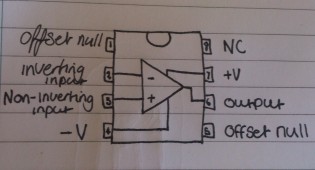
Practical operation amplifier model.


In an ideal operational amplifier (op amp), the value of rd is considered to be infinite when in actual fact the resistance is around 10MΩ. This value is dependent on the variety of omp amp and generally increases with price. The higher the value of rd, the better.
This same premise also applies to the open-loop gain. It’s value in an ideal op amp is also considered to be infinite, when in actual fact it is around 10M.
ro however is the inverse, as in an ideal op amp it is 0Ω and a typical practical value is about 10Ω,

Using the above formula the following can be derived:

The difference between the voltage on the inverting input and the non-inverting input is equal to the output voltage divided by the gain.
Now assuming ideal values for the gain (infinite), its value can substituted in and the formula can be rearranged.

Any value divided by infinity is equal to zero, therefore:

Looking back at the original formula, the following can be deduced:


Substitute in the value for Vd:

Rearrange:

In addition to this, two more values can be stated when using ideal values.
The value of rd is infinite, therefore no current is flowing into the inverting or non-inverting terminals (Ip = 0A and In = 0A).
The output impedance is 0Ω.















